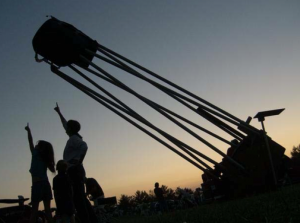The Perseids is one of the best meteor showers to observe, producing up to 60 meteors per hour at its peak. It is produced by comet Swift-Tuttle, which was discovered in 1862. The Perseids are famous for producing a large number of bright meteors. The shower runs annually from July 17 to August 24. It peaks this year on the night of August 12 and the morning of August 13. The waning gibbous moon will block out many of the fainter meteors this year, but the Perseids are so bright and numerous that it should still be a good show. Best viewing will be from a dark location after midnight. Meteors will radiate from the constellation Perseus, but can appear anywhere in the sky.
Please read the C.M. Crockett Page for park details.
Please read the C.M. Crockett Page for park details.
The radiant point for the Draconid meteor shower almost coincides with the head of the constellation Draco the Dragon in the northern sky. That’s why the Draconids are best viewed from the Northern Hemisphere. The Draconid shower is a real oddity, in that the radiant point stands highest in the sky as darkness falls. That means that, unlike many meteor showers, more Draconids are likely to fly in the evening hours than in the morning hours after midnight. This shower is usually a sleeper, producing only a handful of languid meteors per hour in most years. But watch out if the Dragon awakes! In rare instances, fiery Draco has been known to spew forth many hundreds of meteors in a single hour. In 2015, the waning crescent moon rises at late night and will not intrude on this year’s Draconid shower. Try watching at nightfall and early evening on October 7 and 8.
This shower runs annually from October 2 to November 7. It peaks this year on the night of October 21 and the morning of October 22. The Orionids are meteors left behind in the wake of Halley’s Comet.

For more information on the event and the flyer – http://www.novac.com/wp/outreach/stargaze/
The Leonids is an average shower, producing up to 15 meteors per hour at its peak. This shower is unique in that it has a cyclonic peak about every 33 years where hundreds of meteors per hour can be seen. That last of these occurred in 2001. The Leonids is produced by dust grains left behind by comet Tempel-Tuttle, which was discovered in 1865. The shower runs annually from November 6-30. It peaks this year on the night of the 17th and morning of the 18th. The nearly new moon will not be a problem this year. Skies should be dark enough for what should be good show. Best viewing will be from a dark location after midnight. Meteors will radiate from the constellation Leo, but can appear anywhere in the sky.
The public night scheduled for 18 November is canceled. Although the Clear Sky Chart[1] currently says only 50% of the sky will be covered by clouds, all of the other forecasts predict “cloudy”[2] or “mostly cloudy”[3][4] with a chance of precipitation. DC television weather-guessers all agree it will be mostly cloudy tomorrow evening with differing opinions on the timing and amount of precipitation.
Hoping for clear skies for future public nights,
R. J. ‘Tree’ Greenwood
Crockett Park Site Coordinator
[1] http://www.cleardarksky.com/c/CrckttPrkVAkey.html
[2] https://www.accuweather.com/en/us/midland-va/22728/hourly-weather-forecast/2111280?hour=40
[3] https://weather.com/weather/hourbyhour/l/22728:4:US
[4] https://www.wunderground.com/hourly/us/va/midland/date/2017-11-18?cm_ven=localwx_hour
Please read the C.M. Crockett Page for park details.
The Geminids is the king of the meteor showers. It is considered by many to be the best shower in the heavens, producing up to 120 multicolored meteors per hour at its peak. It is produced by debris left behind by an asteroid known as 3200 Phaethon, which was discovered in 1982. The shower runs annually from December 7-17. It peaks this year on the night of the 13th and morning of the 14th. The waning crescent moon will be no match for the Geminids this year. The skies should still be dark enough for an excellent show. Best viewing will be from a dark location after midnight. Meteors will radiate from the constellation Gemini, but can appear anywhere in the sky.
Please read the C.M. Crockett Page for park details.

